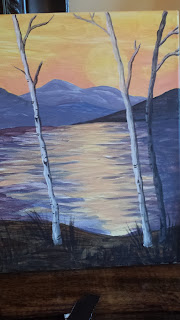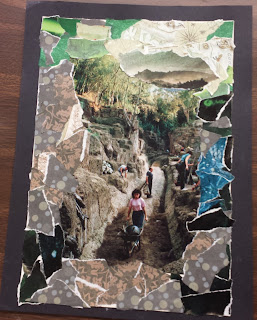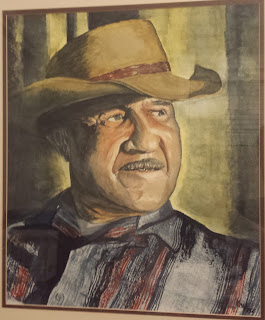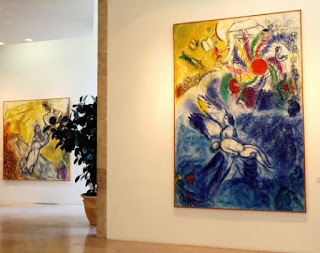I'll be the guinea pig for the initial interview, then follow up with interviews with other local artists. Art is something I've engaged in for my whole life though never professionally. To get the ball rolling I've selected the following 10 questions from the Artwork Archive site's article, 50 Terrific Topics to Write About for Your Art Blog. My plan is to allow artists to answer the ones of their choosing. Here are my own answers:
1. What is your philosophy as an artist?
Anyone can do art. It takes practice and effort to be good at it, but who really cares as long as it pleases you. I want people to enjoy doing art, but I am happy if they simply like looking at it, and even happier if they are willing to talk about it with others. I admire those who do art and humbly try new mediums to learn and improve.
Aristotle said, "The aim of art is to represent not the outward appearance of things, but their inward significance." So what I may produce is an expression of something inside of me the significance of which may or may not appeal to you. Or vice-versa!
2. Why do you create art?
 |
Reflections of a Starry Night (niece, me, daughter)
|
Most of the art I do is a demonstration or socializing of art with others. It’s fun to explore new mediums. I feel a sense of accomplishment on an even greater scale when I’ve encouraged others to do art. I like talking about art and getting others to do so as well. Once as a youth, my brother and I were commissioned to decorate a wall in our dentist’s office. I recall it being a circus theme. Fun!
I enjoy developing or adapting art projects for my various classes, making customized birthday cards, and doing Paint Nights with my family.
 |
Sunrise Over Mt. Rainier, Ken
|
At my very first Paint Night, my daughter and I chose to paint Mt. Rainier. This was actually my first adult attempt at using acrylic as a medium.
 |
Menagerie (1998), Mr. Patterson
|
One of my favorite and most ambitious projects was this 'stained glass' coloring book page cutout. This was an early lesson I taught in my daughter's 6th-grade class. The easy part was creating a tissue paper collage for the background. For the positive-negative space portion, I challenged students to cut apart a drawing of an animal from a coloring book, then trace the pieces onto a piece of black construction paper to later cut out. Mine combined three animals (with odd additions) into a Surrealist composition. You need to have a teacher who really loves art and allows extra sessions to complete such a project.
 |
Sunset (2019), Patterson
|
I painted this acrylic landscape in preparation for my own Paint 'n' Sip class that was to be held at a small local coffee shop.
3. Why do you work in the medium that you do?
 |
| Collage Landscape by an FTJ Student |
If I had more time, I’d do more watercolors. Acrylics and even pastels give me more instant gratification. I taught myself to do pastels for a class I taught with Seniors. My family and I created sample works as a dry-run for my lesson and to try out the pastels that I purchased for the class. One of my best, most successful, and enjoyable art classes was doing collage portraits with seniors. When working with paper cutouts, it's like we're channeling Henri Matisse.
 |
Cowboy (1982), Ken Patterson
|
My watercolor Cowboy was painted from a small photograph taken from a magazine many years ago. It uses many of the techniques I learned in a class that I took at Everett Community College just after I started working in Washington State.
 |
Clown (1968), Kenny Patterson
|
When both my parents died in August of 2011, I managed to eventually retrieve my oil painting of an Emmett Kelly-style circus clown that my Dad kept over the years. It must have meant something to him. In 6th-grade, my teacher, Mrs. Douglas allowed me to prominently display this painting, along with probably a dozen others, in a school display case. Somewhere, there's a snapshot of me proudly kneeling in front of it.
4. How did you teach yourself?
I read lots of art books like this one co-authored by artist, Andrew Wyeth. My passion for art gives me the energy to try new things and explore new artists. Every lesson teaches me something new. I will do my own art, research supplies and techniques, and come up with lots of examples to inspire my students. Reading other blogs and researching on the Internet helps me delve deeper into an artist’s background, life history, elements of their style, or other obscure details. I’ve become a better writer by editing daily blog posts and researching online for information to share with my readers and eventually my students.
5. What have you learned by
teaching a class or hosting workshops?
Travel is another way that I teach myself about art. Trips like this one to seven Baltic countries are invaluable learning opportunities. I’ve honed my public
speaking skills, learned to plan ahead, order supplies, and ask for a stipend
in advance. I’ve learned that I can teach to a variety of age groups and
capability levels and am able to adjust almost any lesson plan to fit. I’ve
learned different ways of looking at art and often discovered something I
didn’t see or know when discussing it with others.
6. What would you do differently or the same in your art career looking back?
It was the right choice to pursue Engineering, although I always wonder what would have happened if I stayed the course to become an Architect. Expanding into the emerging field of computer software was the best and most creative path for me. I would have loved to have worked in an Advertising Agency. I’m glad that I have volunteered in the visual arts for the past 28 years.
I am in awe of those people who make the time to write and illustrate children's books. And that extends to those who share their craft and artistic techniques by writing books about different mediums.
7. What have you learned using social media for your blogging?
 |
Delifrance Advertisement
|
I’ve learned that reading other blogs and making comments causes spikes in my number of daily reads. My wife also posts about my blog on Facebook. I have yet to turn my blogging into a business, mainly because I feel I wouldn’t have control over what ads are shown. I need more foot traffic before I go seeking the bread (I do like this Delifrance ad). Maybe online teaching will inspire me to sell some of my lesson plans on Etsy.
8. Which advice should you have listened to or ignored starting out
as an artist?
Decide early on whether you want to pursue a career based on your aptitude for certain subjects
(e.g. math or science) or one that is based on your interests or someone you admire. For me, studying Architecture in college was very competitive and students were constantly weeded
out in favor of those who caught the eye of the teaching staff. I was lucky enough to
discover software development, and eventually, earned a Master’s degree in Project
Management, finding that I enjoyed running things from the top-down.
9. What strategy tips do you have for an art career?
Find a mentor who knows
the business side of art. Find someone whom you admire and try job shadowing. Emerging technology makes a career in art more possible and
lucrative nowadays. It may even be merged with a career in technology.
10. What was the most valuable thing you learned about art in school?
 |
Marc Chagall Museum, Nice France
|
I was once told that bigger is better when learning to express yourself, so I always shy away from doing tiny drawings. When I teach, I try to limit the constraints, expecting that my students will learn from my lesson, but secretly hoping they go outside the box and create something surprising. Constraints are meant as guidance so that no artist is left staring at a blank sheet of paper. You should keep going even if you feel like you made a mistake. I don’t allow students to throw away their work or start over.
Just look at all of the studies created by famous artists that have survived them!
A judgment-free zone is critical in creating art, so I always try to find something good to say about anyone’s art. Besides, when I’m teaching it’s more about the process than the final result. However, I do love happy accidents!















No comments:
Post a Comment
Do you have a favorite art movement or style? What's your favorite abstract artwork?